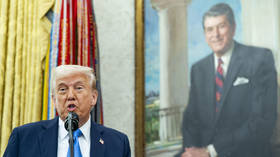China’s yuan to become world’s third-largest reserve currency behind dollar & euro – Morgan Stanley

With Beijing pushing for greater use of the yuan internationally, the Chinese currency could rise to the status of the world’s third-largest reserve currency in 10 years, according to a forecast by Morgan Stanley.
The share of the yuan in global foreign exchange reserve assets could more than double from its current level of two percent and surpass the share of the Japanese yen and the British pound, the bank’s analysts said in a report released on Friday, cited by CNBC.
According to their estimates, the Chinese currency, officially known as the renminbi or RMB, could reach five to 10 percent of reserve assets by 2030.
Also on rt.com China expanding pilot testing of digital yuan to have it ready by 2022“[This target] is not unrealistic in light of the financial market opening in China, the growing cross border capital market integration we see across equities and fixed income and an increasing proportion of China’s cross-border transactions being denominated in RMB,” Morgan Stanley international strategist James Lord said.
All of this suggests global central banks will need to hold more RMB as part of their reserves.
The bank has not changed its positive outlook for the yuan despite the impact of the coronavirus pandemic on the Chinese economy as well as the rest of the world. The latest forecast confirms an earlier one made by the bank at the beginning of last year. More and more central banks worldwide have been gradually stockpiling yuan in their coffers. According to Morgan Stanley, at least 10 regulators added the currency to their forex reserves last year, with the total number of holders reaching 70.
Also on rt.com Russia calls on fellow BRICS countries to DUMP US DOLLAR in favor of trade in national currenciesInternational Monetary Fund (IMF) data shows that the renminbi share in global reserves has doubled since it was included in the IMF’s basket of major reserve currencies in October 2016. Back then, the share of the yuan amounted to one percent, and now it stands at 2.02 percent. Its main rivals – the yen and the British pound – have a 5.7 percent and 4.43 percent share respectively. The US dollar accounts for almost 62 percent of global forex holdings and the euro for over 20 percent.
While some analysts noted that the yuan is not going to unseat the dollar from the leading position anytime soon, other forecasts signaled that the greenback has been losing its grip on global markets. Earlier this year, Goldman Sachs strategists warned that there are “real concerns around the longevity of the US dollar as a reserve currency.”
For more stories on economy & finance visit RT's business section













